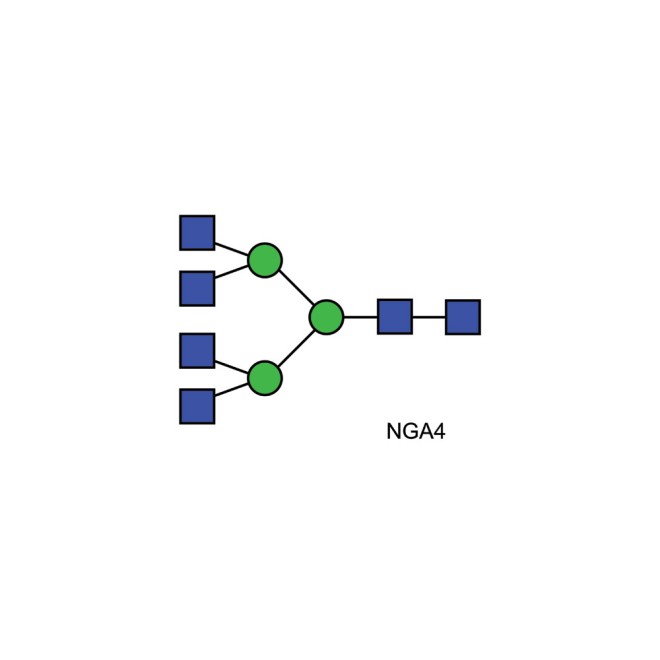NGA4 glycan (A4)
Tetraantennary N-glycan that contains terminal N-acetylglucosamine residues. (size: 10µg) m/z: 1722.6453
NGA4 N-linked oligosaccharide: Asialo-, agalacto-, tetra-antennary complex-type N-glycan (oligosaccharide). NGA4 is a substructure of glyans found on several mammalian glycoproteins including human alpha-1 acid glycoprotein (hAAGP). This product is typically purified from the oligosaccharide pool released from hAAGP by hydrazinolysis using a combination of HPLC and glycosidase digestion.
Product Specification
NGA4 Glycan Synonyms: NGA4 N-linked oligosaccharide
Description: Asialo-, agalacto-, tetra-antennary complex-type N-glycan (oligosaccharide).
Molecular Weight: 1724
Purity: >90% pure as assessed by a combination of 1H-NMR and HPLC.
Sources: NGA4 is a substructure of glycans found on several mammalian glycoproteins including human alpha-1 acid glycoprotein (hAAGP). This product is typically purified from the oligosaccharide pool released from hAAGP by hydrazinolysis using a combination of HPLC and glycosidase digestion.
Form: Dry. Dried by centrifugal evaporation from an aqueous solution.
Storage: -20˚C both before and after dissolution. This product is stable for at least 5 years as supplied.
Shipping: The product can be shipped at ambient when dry. After dissolution, ship on dry ice.
Handling: Allow the unopened vial to reach ambient temperature and tap unopened on a solid surface to ensure that most of the lyophilized material is at the bottom of the vial. Gently remove the cap, add the desired volume of reconstitution medium, re-cap and mix thoroughly to bring all the oligosaccharide into solution. For maximal recovery of oligosaccharide, ensure that the cap lining is also rinsed and centrifuge the reconstituted vial briefly before use. Ensure that any glass, plasticware or solvents used are free of glycosidases and environmental carbohydrates. Minimise exposure to elevated temperatures or extremes of pH. High temperatures and low pH will cause desialylation. High pH will cause epimerisation of the reducing terminus GlcNAc.
Safety: This product is non-hazardous and has been purified from natural sources certified to be free of all hazardous material including pathogenic biological agents.
Related Products
| Ludger Cat. # | Description |
|---|---|
| CN-NA4-x | NA4 Glycan (galactosylated parent of NGA4) |
Warranties and liabilities
Ludger warrants that the above product conforms to the attached analytical documents. Should the product fail for reasons other than through misuse Ludger will, at its option, replace free of charge or refund the purchase price. This warranty is exclusive and Ludger makes no other warrants, expressed or implied, including any implied conditions or warranties of merchantability or fitness for any particular purpose. Ludger shall not be liable for any incidental, consequential or contingent damages.
This product is intended for in vitro research only.



-660x660.jpg)
